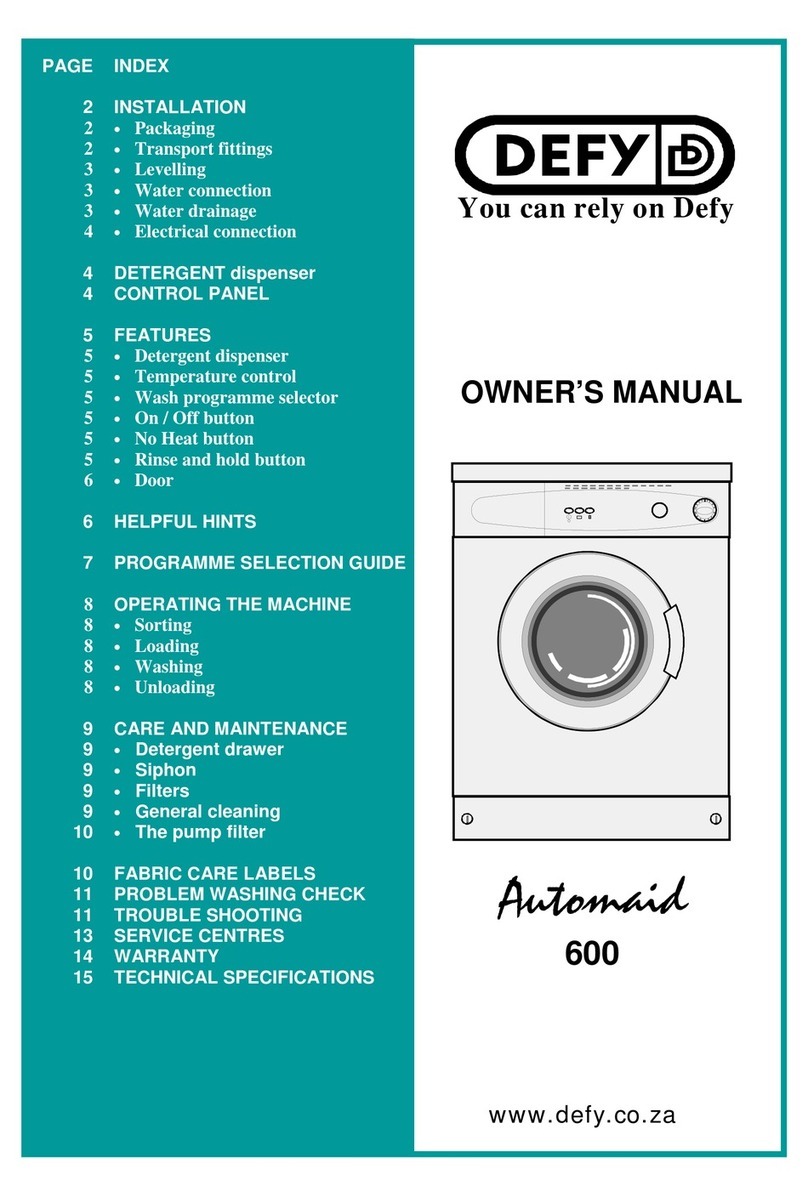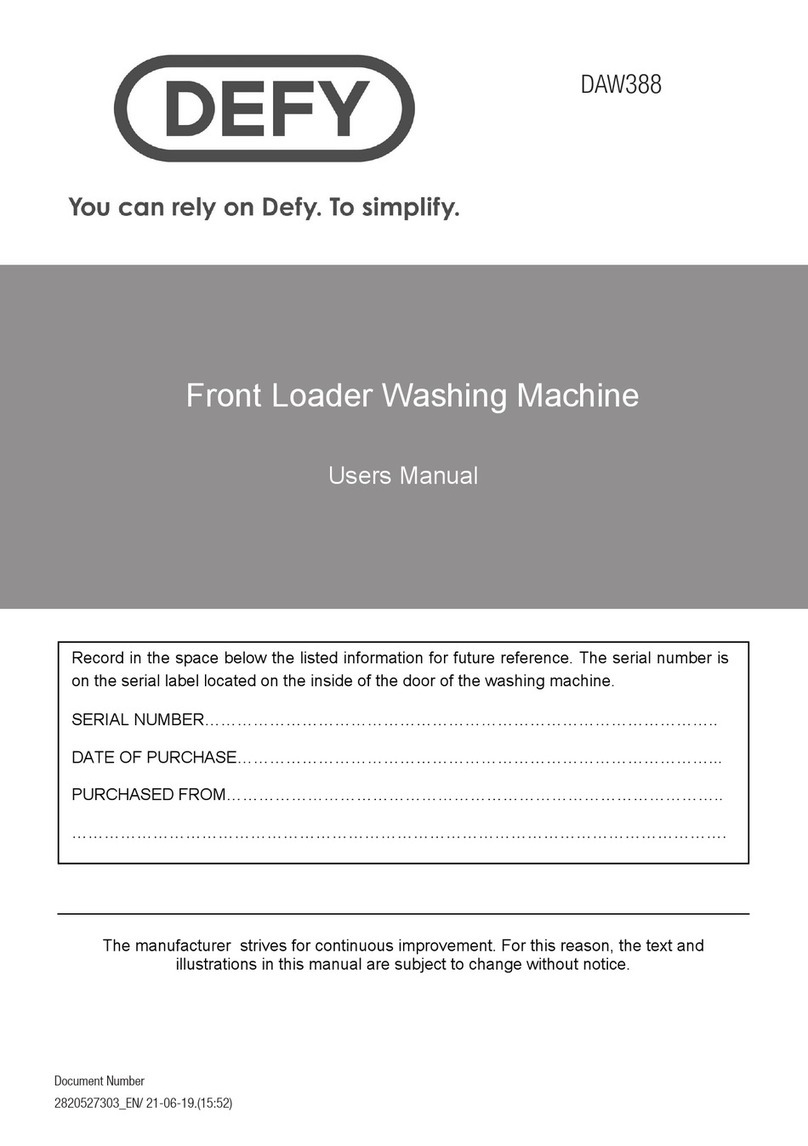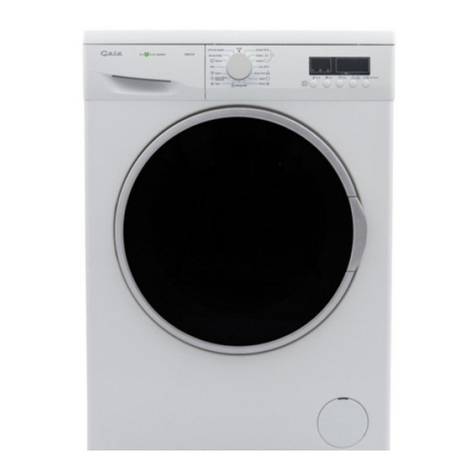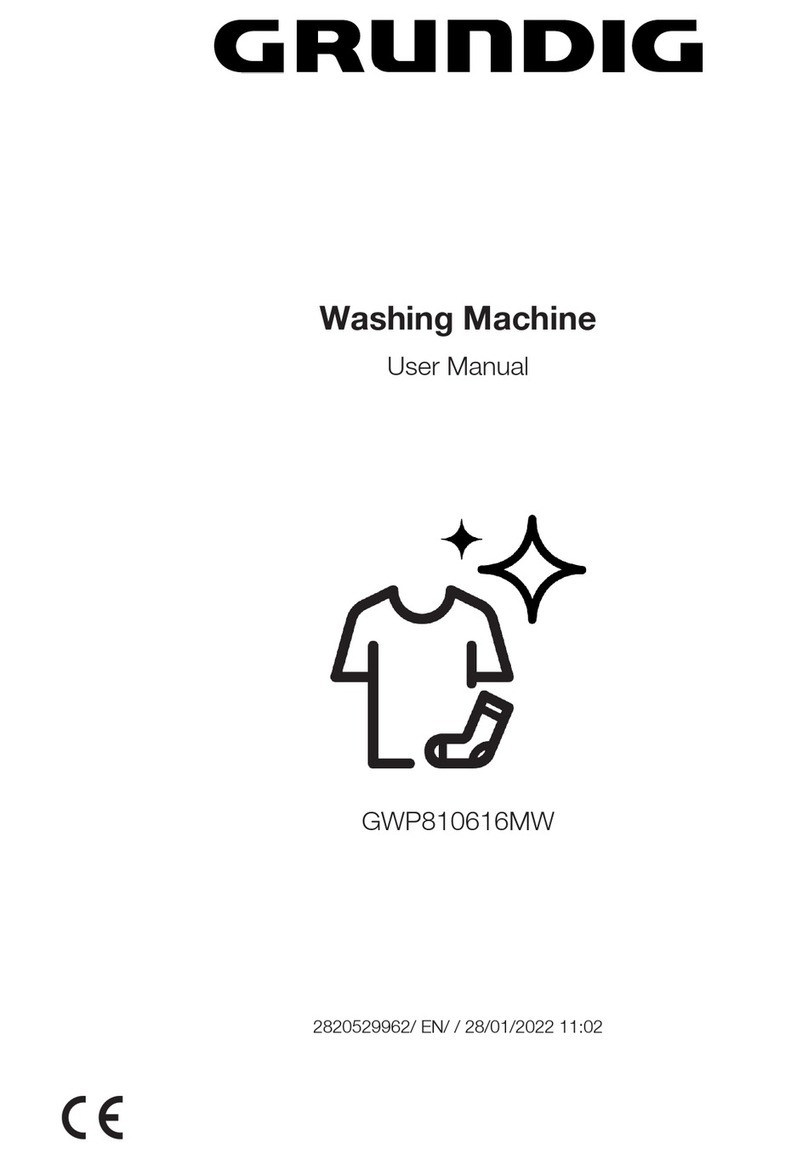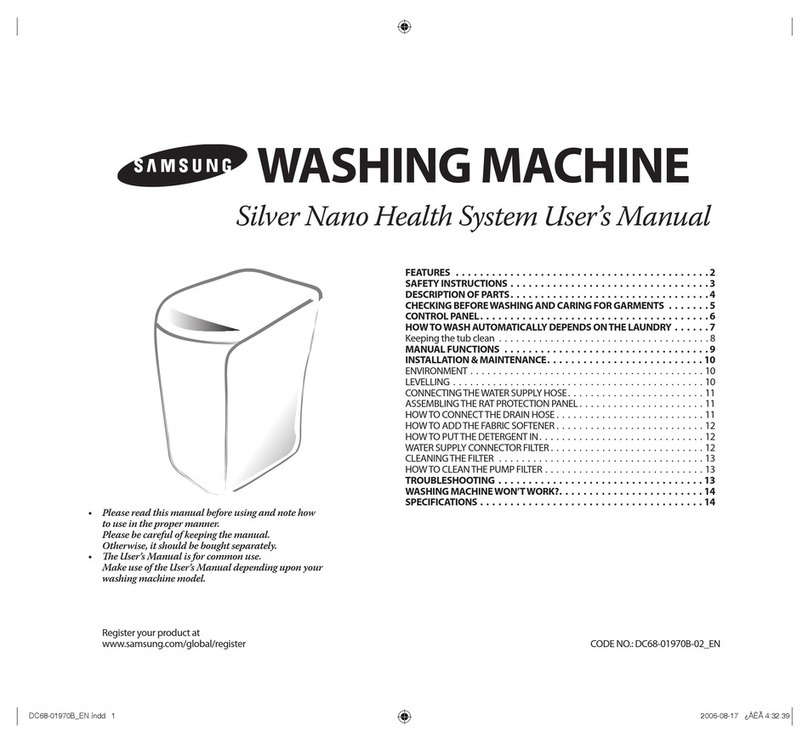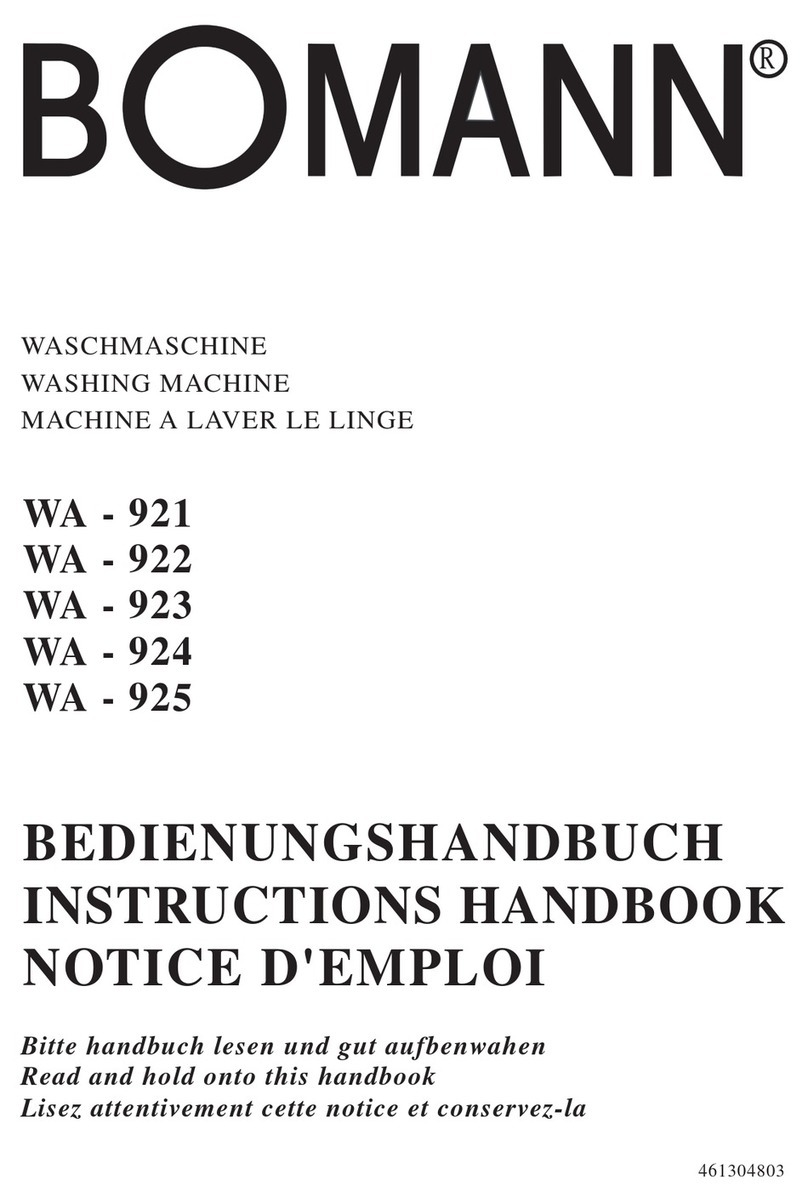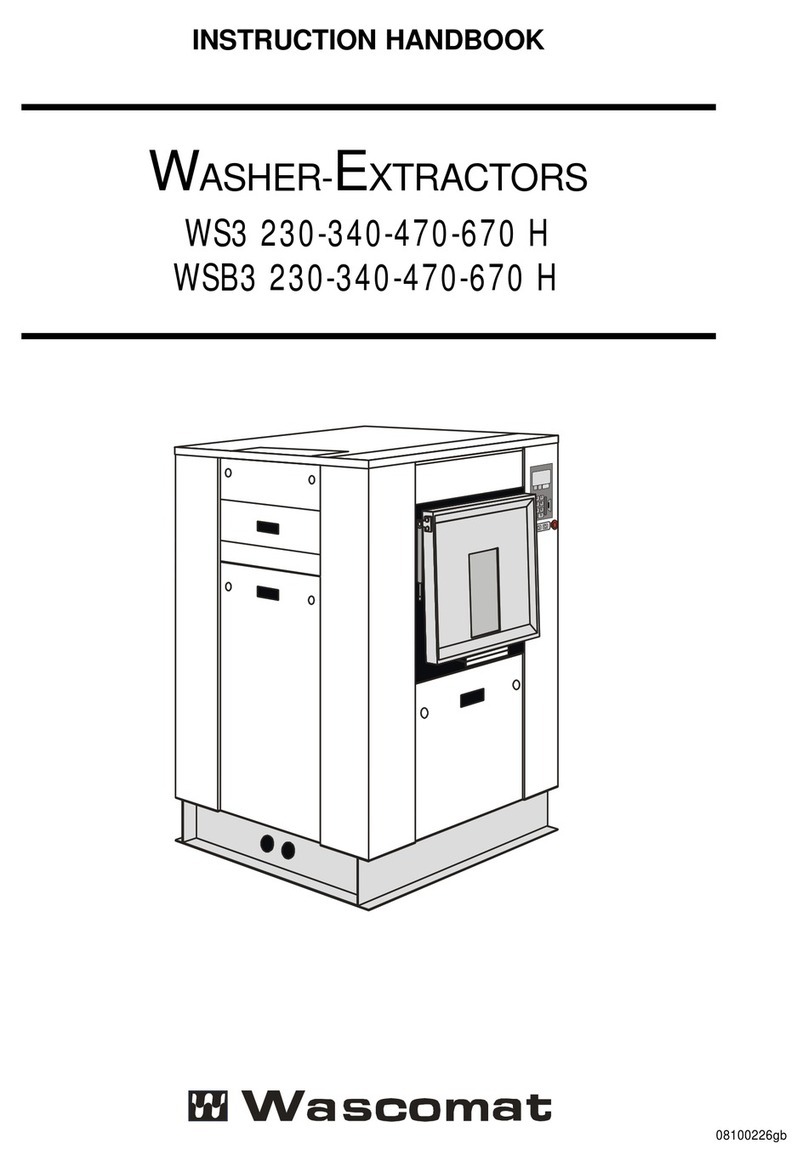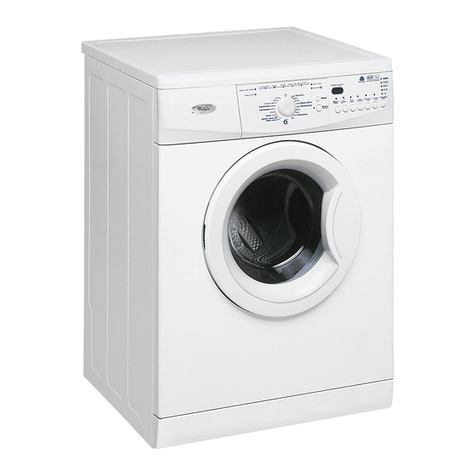Defy DTL165 User manual

Page 1
DTL165
TOP LOADER WASHING MACHINE
Laundry
Instruction manual
Part number: 074879 AA

Page 2
Introduction
Dear Customer,
Your new Defy top loader washing machine was manufactured in a state of the art facility and
has passed the strictest quality control procedures.
Please read this manual carefully before using your washing machine for the first time and
then store it within easy reach for future reference.
This manual will provide you with information on how to operate and care for your washing
machine to gain the maximum benefit from it.
We trust you will enjoy years of trouble free use.
EXPLANATION OF SYMBOLS
Important information
Warning—Hazardous situations
Warning—Electric shock
PLEASE REGISTER YOUR PRODUCT AT
www.defy.co.za
DEFY APPLIANCES (PTY) LTD
P.O.BOX 12004
JACOBS
DURBAN
4026
SOUTH AFRICA
Contents
Introduction 2
Important safety instructions 3
Preparation 6
Know your washing machine 7
Installation 8
Sorting the laundry 10
Preparation before initial use 12
Operating the washing machine 14
Programme and consumption table 17
Maintenance and cleaning 18
Troubleshooting 20
Error codes 21
Technical specifications 22
Disposing of the old washing machine 22
Customer care 23
Warranty 24
Figures in this manual are
schematic and may not match your
machine exactly.

Page 3
General safety
• This washing machine is not
intended for use by persons
(including children) with
reduced physical, sensory or
mental capabilities or lack of
experience and knowledge
unless they have been given
supervision or instruction
concerning the use of the
washing machine by a person
responsible for their safety.
• Children should be supervised
to ensure that they do not play
with the washing machine.
• Never place the washing
machine on a carpeted floor.
Lack of airflow beneath the
machine could cause
overheating.
• In case of a malfunction or
maintenance work, disconnect
the washing machine from the
electrical mains immediately.
Repairs must only be made by
a qualified technician.
• Before washing, check all
clothes for loose buttons and
tears. Check pockets for coins ,
pins or other small articles.
Close zips and fasteners. Wash
small articles inside a pillow
case.
• Do not connect the valve to the
hot water supply if the product
is intended to be connected to
the cold water supply only.
• Do not connect the cold water
valve to the hot water supply if
the product incorporates two
valves. The red is for hot water
and the blue is for cold water.
Important safety instructions
• Do not wash clothes stained
with or soaked in petrol,
thinners, kerosene, vegetable
oil or any other flammable
liquids. Nor should any of these
liquids be added to the wash
water as they constitute a fire
hazard or there may be a risk
of an explosion.
• Only use the machine for
washing fabrics. Do not attempt
to wash plastic leather or
fibreglass. Sort and separate
clothes by fabric, colour and
degree of dirt.
• Use detergents, softeners and
supplements suitable for top
loading automatic washing
machines only.
• Always unplug the machine
from the wall socket when it
requires cleaning or service.
Only permit qualified persons to
repair or install parts in the
washer.
• Do not use water which is
hotter than 50 degrees Celsius
as this may deform plastic parts
of the machine. which could
result in injury, electric shock or
water leakage.
• The water supply and draining
hoses must be securely
fastened and remain
undamaged to prevent water
leakage.
• Check the water supply hose
connection by turning on the
water before washing and
ensure there is no water
leakage.
• Follow the instructions on the
textile tags and on the
detergent package.

Page 4
• Repair procedures must be
carried out by an Authorized
Service Agent. Repairs carried
out by incompetent persons
create a user risk: There may
be a risk of accidental fire. If
the washer operates
abnormally, it may cause an
injury. Defy shall not be held
liable for damages that may
arise from procedures carried
out by unauthorized persons.
• Do not expose the machine to
any type of flame or put
cigarettes or any volatile
substances on the machine
top. The machine may catch
fire or the machine may be
deformed due to its large
number of plastic components.
• Do not install the machine in a
bathroom or very humid place.
Doing so may cause a
malfunction or result in a short
circuit and there is a risk of an
electric shock.
• Never wash the machine by
spreading or pouring water
onto it! Do not spray water on
to the control panel and back of
the machine. There is a risk of
an electric shock, and the
machine may malfunction.
• Do not wash, rinse or spin
water proof fabrics such as
sleeping bags, raincoats, car
covers etc. Washing these
types of materials may lead to
injury through abnormal
vibration during spinning or
damage may result to the
washing machine, wall, floor
and clothes.
Warning! Never reach
into or put your hands
into the wash/spin tub
whilst the machine is
operating. If you reach
into the wash/spin tub
serious injury could
result. Wait until all
motion stops.
Warning! If the wash/spin
tub does not stop within
15 seconds after the
washer lid is opened,
switch the washer off
immediately and call the
customer care line on 086
100 3339.
Warning! The machine
must be unplugged
during installation,
maintenance, cleaning
and repairing procedures
to avoid the risk of an
electric shock.
• Keep hands and feet away
from the bottom of the washing
machine when it is in use to
avoid the risk of injury.
• Do not stand on the washing
machine or place weight on the
washing machine. Damage to
the washing machine may
result and there is a risk of
personal injury.

Page 5
• Turn off the water supply at the
tap when the washing machine
is not in use to minimise the
risk of damage that could arise
from water leakage. Unplug the
washing machine if it is not
going to be used for a long
period of time.
• Ensure that the water inlet pipe
is connected and the tap
opened before washing
clothes.
Intended use
• The washing machine is only
domestic use and for the
purposes for which it was
designed.
Transportation of the machine
1. Unplug the machine before
transporting it.
2. Remove water drain hose and
water supply hose connections.
3. Drain all remaining water from
the machine.
Ensure that the power plug and
power cord are properly
connected.
• Never touch the plug with wet
hands!
• Never unplug by pulling on the
cable, always pull out by
grabbing the plug.
• Do not operate a damaged
washing machine.
• If the power cable is damaged,
it must be replaced by the
manufacturer, after sales
service or a similarly qualified
person.
• Never plug the washing
machine into the wall socket
during installation. Death or
serious injury may result.
• For safety reasons, the wall
socket and the plug should be
accessible after installation.
• Do not make connections via
extension cables or multi-plugs.
• Pull out the plug from the wall
socket if the machine is not
going to be used.
Children's safety
• Electrical products are
dangerous for children. Keep
children away from the washing
machine when it is in use. Use
child lock to prevent children
from tampering with the
washing machine controls.
• Do not allow children to play on
or in the machine. If a child
accidentally falls into the wash/
spin tub, serious injury could
occur. Close the lid when
leaving the room where the
machine is located.
Keep children away from the
washing machine and keep
boxes or steps well away from
the washing machine to
prevent children from stepping
up and accessing the controls,
lid and wash tub of the washing
machine.
• Do not allow children to sit on
the washer.
Electrical connection
• The washing machine must be
earthed and the manufacturer
and seller do not accept
responsibility for any damage
due to incorrect electrical
connection.
• Connection must comply with
national regulations.

Page 6
Preparation
Preparation of location, electrical,
tap water and waste water
installations of the machine are the
customer's responsibility.
Ensure that the water inlet,
discharge hoses and power cable
are not folded, pinched or crushed,
during or after installation or
cleaning procedures.
Warning: Prior to installation,
visually check if the machine has
any defects on it. If so, do not
install it. A damaged machine is a
safety risk.
Things to be done for energy saving
• Always follow the instructions on the
detergent packaging.
• Wash slightly soiled laundry at low
temperatures.
• Use faster programmes for small
quantities of lightly soiled laundry. Before moving the machine, take note of
figure A on how to carry the machine.
Figure A
Remove package
• Remove package and take out the bottom
board of the cabinet on the foam cover.
• Open the washer door lid and take out the
accessories.
• Never perform a trial operation or run the
washing machine on the foamed cushion
as this is extremely dangerous.
Warning: Packaging materials
are Dangerous to children. Keep
packaging materials in a safe place
away from the reach of children.

Page 7
The manufacturer strives for continuous improvement. For this reason, technical
specifications, text and illustrations in this manual are subject to change without
notice.
Figures in this manual are schematic and may not match your machine exactly.
Values stated on the machine labels or in the documentation accompanying it are
obtained in laboratory conditions in accordance with the relevant standards.
Depending on operational and environmental conditions of the machine, these
values may vary.
Know your washing machine
1 Lid Frame
2 Lid Glass
3 Top Cover
4 Detergent drawer
5 Control Panel
6 Power Cord
7 Cabinet
8 Drain hose
9 Inlet Hose

Page 8
Review information in the user manual and
ensure that the electricity, water supply and
water drainage systems are appropriate. If
they are not, call a qualified technician and
plumber to have any necessary
arrangements carried out.
Appropriate installation location
• Place the machine on a rigid floor that has
sufficient load carrying capacity.
• The machine height is only adjustable at
the front. The machine needs to be
orientated on a floor that is level on either
side and the back is either level or higher
than the front.
• Choose a well ventilated dry location out
of direct sunlight.
• Do not place the machine on the power
cable.
• Do not install the machine at places where
the temperature may fall below 0ºC.
• Place the machine at least 10 cm away
from the edges of other furniture.
• Hot and cold water taps should be located
within 1 metre of the inlet valves.
Connecting the water supply
The water supply pressure required
to run the machine is between 1 to
10 bars (0 1 - 1 MPa).
It is necessary to have 10 - 80 litres
of water flowing from the fully open
tap per minute in order to have
your machine run smoothly. Attach
a pressure reducing valve if the
water pressure is higher.
In *models with two water inlet
valve, hot water supply should be
connected to red colour marked
water inlet valve; cold water supply
should be connected to blue colour
marked water inlet valve.
should not be connected to the hot
water tap.
Installation 1. Connect the special hoses supplied with
the machine to the water inlets on the
machine.
Warning: Ensure that the cold
and hot water connections are
made correctly when installing the
machine to prevent your laundry
coming out hot at the end of the
washing process and wearing out.
2. Tighten all hose nuts by hand. Never use
a tool when tightening the nuts.
3. Open the taps completely after completing
the hose connection to check for water
leaks at the connection points. If any
leaks occur, turn off the tap and remove
the nut. Retighten the nut carefully after
checking the seal. To prevent water
leakages and damages caused by them,
keep the taps closed when the machine is
not in use.
• The hose should be attached to a height
of at least 65 cm, and 100 cm at most.
• In case the hose is elevated after laying it
on the floor level or close to the ground
(less than 65 cm above the ground), water
discharge becomes more difficult and the
laundry may come out excessively wet.
Therefore follow the heights as per the
following figure.
Connecting to the drain
• The end of the drain hose must be directly
connected to the wastewater drain or to
the washbasin.
Warning: Flooding will occur if
the hose comes out of its housing
during water discharge. There is
risk of scalding due to high
washing temperatures! To prevent
this and to ensure smooth water
intake and discharge of the
machine, secure the end of the
discharge hose tightly so that it
cannot dislodge easily.

Page 9
• To prevent flow of dirty water back into
the machine and to allow for easy
discharge, do not immerse the hose end
into the dirty water or do not push it in the
drain by more than 15 cm. If it is too long,
cut it shorter.
• The end of the hose should not be bent, it
should not be stepped on and the hose
must not be pinched between the drain
and the machine.
• If the length of the hose is too short, use it
by adding an original extension hose.
Length of the hose may not be longer
than 3.2 m. To avoid water leakage, the
connection between the extension hose
and the drain hose of the machine must
be properly fitted with an appropriate
clamp so as not to come off and leak.
1. Unplug the machine before transporting it.
2. Remove the water drain and water supply
connections.
3. Drain all the water that has remained in
the machine.
4. Fit the polystyrene and then package the
machine.
Transportation of the machine
Placing the rat mesh on the machine:
In case of risk of rats, you can assemble the
rat mesh under the base of the machine on
chassis with the help of screw provided
along with accessories as shown in the
image.
Adjusting the feet for levelling
Rat mesh (Depends on model)
A rat mesh is not supplied with the machine.
If required, a rat mesh may be purchased
from Defy spares.
When the washing machine is not levelled
you can lift the washing machine from front,
then rotate it to the left or right to adjust the
feet and make it even.
Check the level by the help of the levelling
indicator on the top cover. Ensure that the
air bubble inside the levelling instrument is in
the center of the circle during installation and
before operating the machine.
Disposing of the washing machine
• This washing machine has been
manufactured with high quality parts and
materials which can be reused and are
suitable for recycling.
• Do not dispose of the machine with
normal domestic waste at the end of its
service life.
• Please consult with your local authorities.
Should you at any time in the future scrap
the washing machine, cut the power cord,
and take measures to render the door
inoperative thereby preventing children,
when playing, getting trapped inside.
Ensure parts and accessories are
Installed according to the directions
given in this instruction manual. .
The front feet of the washing machine can
be adjusted.

Page 10
Using detergent /softener and bleach
• Add detergent and softener before
starting the washing program.
• Never leave the detergent drawer open
while the washing program is running!
• Place the detergent bag or the dispensing
ball directly among the laundry in the
machine if you use them.
Choosing the Detergent Type
The type of detergent to be used depends
on the type and colour of the fabric.
• Use different detergents for coloured and
white laundry.
• Wash your delicate clothes only with
special detergents (liquid detergent, wool
shampoo, etc.) used solely for delicate
clothes.
• Wash woolens with special detergent
made specifically for woolens.
WARNING: Use only detergents
manufactured specifically for
washing machines.
WARNING: Do not use soap
powder.
Adjusting the Detergent Amount
The amount of washing detergent to be used
depends on the amount of laundry, the
degree of soiling and water hardness.
• Pour the detergent into the main wash
compartment of the detergent drawer.
• Do not use amounts exceeding the
dosage quantities recommended on the
detergent package. This avoids problems
of excessive foam, poor rinsing, financial
savings and finally, environmental
protection.
• Use less detergent for small amounts or
lightly soiled clothes.
Using Softeners
Pour the softener into the softener
compartment of the detergent drawer. If your
machine has a simple detergent drawer
(detergent drawer that does not include
softener compartment) softener can be put
in the dedicated compartment on the
balance ring.
• Do not exceed the (>max<) level marking
in the softener compartment.
• If the softener has lost its fluidity, dilute it
with water before putting it in the
detergent drawer.
Using Gel and Tablet Detergent
Apply the following instructions when using
tablet, gel, and similar detergents.
• If the gel detergent thickness is fluidal, put
the gel detergent into the main wash
detergent compartment during first water
intake.
• If the gel detergent thickness is not fluidal
or in the shape of capsule liquid tablet, put
it directly into the drum before washing.
• Put tablet detergents into the main wash
compartment or directly into the drum
before washing.
Using Starch
• Add liquid starch, powder starch or the
fabric dye into the softener compartment.
• Do not use softener and starch together in
a washing cycle.
• Wipe the inside of the machine with a
damp and clean cloth after using starch.
Tablet detergents may leave
residues in the detergent
compartment. If you encounter
such a case, place the tablet
detergent between the laundry,
close to the lower part of the drum
for future washings.
Using Bleaches
• Do not use bleaching agent and detergent
by mixing them.
• Use just a little amount of bleaching agent
and rinse the clothes very well as it
causes skin irritation. Do not pour the
bleaching agent onto the clothes and do
not use it for coloured clothes.

Page 11
Sorting the laundry
• Sort the laundry according to the type of
fabric, colour, degree of soiling, and
suitable water temperature.
• Make sure to check the care label on the
clothing and then sort them accordingly
before starting the wash cycle.
• Mix large and small items in each load
When using detergent, softener, starch, fabric dye, bleach or limescale remover
please ensure you read the detergent manufacturer's instructions on the package
carefully and follow the suggested dosage values. Use measuring cup if available.
• Separate heavy soiled items from lightly
soiled ones.
• Separate dark colours from light colours.
• Separate colourfast items from non-
colourfast
• Separate robust fabrics from delicate.
• Separate whites from coloured fabrics.

Page 12
Things to be Done for Energy Saving
The following information will help you use
the product in an ecological and energy-
efficient manner.
Operate the product in the highest capacity
allowed by the program you have selected,
but do not overload; see "Program and
consumption table".
Always follow the instructions on the
detergent packaging.
Wash slightly soiled laundry in warm or cold
water.
Use quicker programs for small quantities of
lightly soiled laundry.
Do not use soaking and hot water for laundry
that is not heavily soiled or stained.
If you plan to dry your laundry in a dryer,
select the longer spin time recommended
during washing process.
Do not use detergent more than the amount
recommended on the detergent package.
Do not use detergent more than the amount
recommended on the detergent package.
Correct Load Capacity
The maximum load capacity depends on the
type of laundry, the degree of soiling and the
washing program desired.
According to the selected water level, the
machine will automatically adjust the amount
of water.
• Laundry items with metal attachments
such as underwired bras, belt buckles or
metal buttons will damage the machine.
Remove the metal pieces or wash the
clothes by putting them in a laundry bag
or pillowcase.
• Take out all substances in the pockets
such as coins, pens, and paper clips, and
turn pockets inside out and brush. Such
objects may damage the product or cause
noise problem.
• Put small size clothes such as infant's
socks and nylon stockings in a laundry
bag or pillowcase.
• Place curtains in without compressing
them. Remove curtain attachment items.
• Fasten zippers, sew loose buttons, and
mend rips and tears.
• Wash "machine washable" or "hand
washable" labeled products only with an
appropriate program.
• Tough stains must be treated properly
before washing. If unsure, check with a
dry cleaner.
• Use only dyes/colour changers and
limescale removers suitable for machine
wash. Always follow the instructions on
the package.
• Wash trousers and delicate laundry
turned inside out.
• Keep laundry items made of Angora wool
in the freezer for a few hours before
washing. This will reduce pilling.
• Laundry that is subjected to materials
such as flour, lime dust, milk powder, etc.
must be intensely shaken off before
placing into the machine. Such substance
on the clothing may build up on the inner
parts of the machine over time and this
can cause damage.
Preparation before initial use

Page 13
During the spin process, if washing is piled to one side of the spin tub it will cause
unbalance of the spin tub. The sensor will pick up the unbalance and will
automatically correct it. If after 3 corrections the unbalance remains the auto
correction cannot resolve the problem then the user must manually place the
clothing evenly inside the tub to resolve the problem.
WARNING: Follow the
information in the “Programme and
consumption table”. When
overloaded, there will be increased
creasing and lint. The machine's
washing performance will drop.
Moreover, noise and vibration
problems may occur.
Load capacity
The load capacity depends on the type of
laundry, the degree of soiling and the
washing program. The machine
automatically adjusts the amount of water
according to the weight of the loaded
laundry.
Laundry type Weight (g)
Bathrobe 1200
Napkin 100
Duvet cover 700
Bed Sheet 500
Pillowcase 200
Tablecloth 250
Towel 200
Hand towel 100
Evening gown 200
Underclothing 100
Men’s overalls 600
Men’s shirt 200
Men’s pajamas 500
Blouses 100
Loading
1.Lift the washer lid.
2.Arrange the articles to be washed loosely
round the perimeter of the tub.
3.Load evenly as an off balance load may
cause unnecessary vibrations.
4.Close the lid and; Ensure that no items are
caught in the lid.
5.Use a large load programme when
washing permanent press garments.
These items need more space to move.
1 On / Off button
2 Start / Pause button
3 Time Delay button
4 Water Level button
5 Spin/Air Dry button
6 Function button
7 Program button
8 Time Display

Page 14
Operating the washing machine
How to start the Child-Lock function:
Press the “Water level” button and ‘’Function’’
button at the same time for 3 seconds. Should
the child lock function be activated, ‘’CL” will
appear in the display for 3 seconds.
To deactivate the Child-Lock:
Press both the “Water level” and “Function”
buttons at the same time to deactivate.
Power Button
Press this button once
to operate. Press again
to switch the power off.
Start/Pause Button
Use to pause and
restart the operation.
To change the washing
procedure during an
operation, press this
button to stop and
again to restart after
changing the
procedure.
Delay Start Time Button
Adjusts delay start time
up to a maximum of 18
hours.
Child Lock
The child lock helps to
protect children from
being accidentally hurt
should they be playing
with the washer.
Water Level Button
The water level is
automatically adjusted.
The water level can still
be selected manually
by pressing this button.
Displays selected
programmes default
water level: Eco / Low /
Medium / High.
Auxiliary Function Button
Each time the Function
button is pressed, the
function changes.
Programme Select Button
Each time the program
select button is
pressed, the washing
programme changes.
Remaining Time, Delay Start Time, Error
Display
Displays remaining
wash time, the
reserved delay start
time and the error code
if a problem occurs in
the washing machine.
(See error codes).

Page 15
Main programmes
Depending on the type of fabric, use the
following main programmes.
Delicate (P6)
Use this program for washing machine
washable delicate (cotton, blended and
wool) items such as sweaters, jumpers,
and cardigans. Hot water and soaking
options cannot be selected in this program.
We recommend using special purpose
detergents suitable for washing delicate
laundry. Light loads only. ((Max 1/3 of full
capacity).
Rinse & spin (P7)
Use this program when you want to rinse
or starch separately. Use this program to
apply an additional spin cycle for your
laundry or to drain the water in the
machine.
Tub clean (P8)
Use this program once a month to sanitize
and clean your machine and to prevent
unwanted odours.
Do not place any items or laundry in the
machine when you use this program, it
must be operated when the washer is
empty otherwise laundry or washer might
be damaged.
Add a special purpose detergent suitable
for cleaning machines.
Soaking, high water and 6 min air turbo
options are set automatically in this
program.
Auto (P1)
This program selects the best water level
and wash program automatically
depending on the amount of laundry. Use
this program for washing cotton and
blended items.
Quick (P2)
This program is suitable for washing a light
load of lightly/daily soiled cotton clothes in
a short time. (Refer to program guide)
Normal (P3)
This program is suitable for washing a full
load of normally soiled durable cotton and
blended clothes.
Heavy (P4)
This program is suitable for washing a full
load of heavily soiled durable cotton and
blended clothes. Soaking function is set
automatically in this wash program. Hot
water inlet valve will be activated if
available with your model.
Blanket (P5)
This program is suitable for washing bulky
laundry items such as blankets and bed
sheets. Fold bulky items in a suitable
manner before placing them in the washing
machine. Do not overload. (Max 1/2 of full
capacity).

Page 16
Auxiliary function selection
Mix / Multicolour (P9)
Fountain wash (P10)
This program is suitable for washing a light
load of normally soiled cotton clothes.
Through the innovative impeller structure
and software design, produces fountain
flow effect for better penetration and textile
care.
Eco
This program is suitable for washing a
lesser amount of lightly/daily soiled laundry
in a short time using minimum amount of
water. (Max 1/3 of full capacity).
Soak
Auxiliary function selection
Select this function if you like to wash your
laundry by soaking. Soaking is
recommended for heavily soiled laundry
items. You can add the normal amount of
detergent and start the wash program by
selecting this function. Soaking is not
selectable in Eco and Wool programs.
Symbols and functions
Spin button • Press this button to change the spin time.
• The spin time can be set as per user preference.
Rinse button • Press this button to change the rinse time.
• The rinse time can be set as per user preference.
Wash button • Press this button to change the washing time.
• The wash time can be set as per user preference.
Time delay
button
• When the time delay button is pressed, the programmes
estimated ending time is displayed.
Remaining
time, Delay
time, Error
display
• Displays remaining wash time, the reserved delay ending time
and error codes.
Timer indicator • Indicates the timer status.
Child lock
indicator • Indicates the child lock status.
Monsoon mode
indicator
• Indicates the monsoon mode running with longer spin time than
normal.

Page 17
Since the following are not factory faults
they are the owners responsibility:
Damage to the exterior finish, breakage of
components, damage through improper use
or installation of the washing machine or
damage caused by moving the washing
machine.
Before calling a Service technician or
your dealer, please check the following:
• Is the machine plugged into the wall
socket? Is the house circuit breaker on?
• Is the machine switched on? Has the
washer lid been closed properly?
• Check if the machine is level.
• Is the detergent dose correct? Is the filter
clean? Is the tap open?
• Is there a water supply to the home? Have
any of the hoses been twisted or kinked?
Programme and consumption table
Programme
Max. Load (kg)
Water level Wash process (min) Function
Time
咁
min
咂
Default
Available
Wash
Rinse
Spin
ECO
Soak
Air Dry
(min)
AUTO Rated load -- 1~10 15(0-20) 2(0-4) 6(0-9) żż30/60/90 45-60
Quick 2 2 1~6 2(0-20) 1(0-4) 3(0-9) × × 30/60/90 15
Normal Rated load 8 1~10 15(0-20) 2(0-4) 6(0-9) żż30/60/90 58
Heavy Rated load 8 1~10 20(0-20) 3(0-4) 9(0-9) × ż30/60/90 80
Blanket Rated load 10 1~10 18(0-20) 2(0-4) 9(0-9) × ż30/60/90 68
Delicate Rated load 6 1~10 8(0-20) 2(0-4) 3(0-9) × × 30/60/90 43
Rinse & Spin Rated load 8 1~10 × 2(0-4) 6(0-9) × × 30/60/90 37
Tub Clean × 8 8 10 2 6 × × 30/60/90 48
MIX/Multicolor Rated load 7 1~10 17(0-20) 2(0-4) 6(0-9) × ż30/60/90 60
Fountain wash 2 4 1~6 13(0-20) 2(0-4) 6(0-9) × ż30/60/90 53
Note: × : Not optional ż: Selectable
Note:
• Soak and Prewash can’t be selected at
the same time.
• Time mentioned in the table will be
varying according to the conditions of
water inlet & water draining.

Page 18
Maintenance and cleaning
If cleaned at regular intervals, the service life
of the machine will be extended and
frequently faced problems will decrease.
Cleaning the detergent drawer
Cleaning the body and control panel
Wipe the body of the machine with soapy
water or non-corrosive mild gel detergents
as necessary, and dry with a soft cloth. Use
only a soft and damp cloth to clean the
control panel.
Cleaning the water intake filters
1. Close the taps.
2. Remove the nuts of the water intake
hoses to access the filters on the water
intake valves. Clean them with an
appropriate brush. If the filters are very dirty,
take them out with the aid of pliers and clean
the filters.
3. Take out the filters on the flat ends of the
water intake hoses together with the gaskets
and clean them thoroughly under running
water.
4. Replace the gaskets and filters carefully in
their places and tighten the hose nuts by
hand.
Draining remaining water and cleaning the
pump filter
The filter system in your machine prevents
solid items such as buttons, coins and fabric
fibres clogging the pump impeller during
discharge of washing water. This ensures
easy water discharge and the service life of
the pump will be extended.
If the machine fails to drain water, the pump
filter is clogged. The filter must be cleaned
whenever it is clogged or once every 3
months.
Water must be drained off first to clean the
pump filter. In addition, prior to transporting
the machine (e.g., when moving to another
house) and in case of freezing of the water,
water may have to be drained completely.
1. Pull out the detergent drawer.
There is a filter at the end of each water
intake valve at the rear of the machine.
These filters prevent foreign substances and
dirt in the water from entering the washing
machine. Filters should be cleaned as they
do get dirty.
Clean the detergent drawer every 4-5
washing cycles to prevent the accumulation
of powder detergent over time. Wash the
detergent drawer with plenty of lukewarm
water in a wash basin. Wear protective
gloves or use an appropriate brush to avoid
skin contact with the residues in the drawer
whilst cleaning. Insert the drawer back into
its place after cleaning and ensure that it is
properly seated.
2. Press down on the drawer from both sides
to release the hook, then take it out by lifting
it. Clean the detergent drawer by water.

Page 19
Warning: Foreign substances
left in the pump filter may damage
the machine or may cause a noise
problem.
In order to clean the dirty filter and
discharge the water:
1. Unplug the machine to cut off the power
supply.
Warning: Temperature of the
water inside the machine may rise
up to 90ºC. To avoid a scalding
risk, the filter must be cleaned
after the water in the machine
cools down.
2. Open the filter cap.
If the filter cap is composed of two pieces,
press the tab on the filter cap downwards
and pull the piece out towards yourself.
3. Only some models are fitted with an
emergency draining hose. Follow the steps
below to discharge the water if your machine
is not fitted with an emergency drain hose.
a. Place a large container in front of the
filter to catch water from the filter.
b. Loosen pump filter (anticlockwise)
until water starts to flow. Fill the flowing
water into the container you have placed in
front of the filter. Always keep a piece of
cloth handy to absorb any spilled water.
c. When the water inside the machine is
finished, take out the filter completely by
turning it.
4. Clean any residues inside the filter as well
as fibres, if any, around the pump impeller
region.
5. Install the filter.
6. If the filter cap is composed of two pieces,
close the filter cap by pressing on the tab. If
it is one piece, seat the tabs in the lower part
into their places first, and then press the
upper part to close.
Discharging the water when the machine
does not have an emergency draining
hose:
Cleaning the fuzz collector
1 Push to take filter out
2.Open the filter and clean. Keep the
filter rubber in the original position.
3. After cleaning assemble the filter in the
correct position.

Page 20
Problem Where to Check
There is no
power.
Check whether there has been a power failure.
Check whether there is blown fuse or tripped circuit breaker.
Check that the power cord is securely plugged in.
The machine
does not work.
Is the washer lid open? Close the lid.
Is the Pause button on? Press the START/PAUSE button one more time
and check if the washer starts.
Has the water filled to the water level?
If the water pressure is low it may take a long time before washing starts.
Is the tap closed? Open the water supply tap.
Water drainage
is very slow
The drain is clogged with coins or pins. Check that the drain hose is not
below 65 cm.
Half fill the spin basket with water and try spinning again.
The water leaks
at the water
supply hose
connector.
If the tap connecting part is loose, water may leak.
Repeat the assembly steps again. (Refer to “Connecting the water supply
hose”).
Check if the rubber seal on the water supply hose is in the correct position.
Screw tightly again.
Is the water supply hose kinked? Straighten the hose.
If the water supply is too strong, water may leak. Close the tap a little.
Is water leaking from the tap itself? Fix the tap.
Water is not
supplied.
Was the Start/Pause button pressed after selecting the water supply? If the
Start/Pause button is not pressed, water is not supplied. Press the Start/
Pause button.
Check whether the water supply tap is open.
Is the filter net at the water supply hose connector clogged? Clean the filter
net by brushing with a toothbrush.
Is the water supply cut off? If so, switch off the tap and power off the
washer.
Check to see that the water pressure is not too low.
Spinning makes
loud noises and
vibrations.
Check if the laundry is spread evenly in the washer. Spread out the laundry
evenly and start again.
Is the washing machine level on a sturdy flat floor. Set the machine level.
Adjust the legs on the feet and ensure they are level.
Is the area around the washing machine cluttered with objects?
Remove unnecessary objects away from the wash machine.
Water does not
drain.
Check that the height of the drain hose is not over 100 cm.
Check that the drain hose is not kinked or obstructed.
Check to see if the water outlet is clogged.
The machine
does not spin.
Check to see that the laundry is evenly distributed and that it has not
clumped on one side of the wash/spin tub.
Check whether the washer is on a level surface. Close the washer lid.
Ensure the lid is not being obstructed from closing.
Other
problems.
Press the POWER ON/OFF button to switch off the power.
Call the customer care line on 086 100 3339.
Troubleshooting
Table of contents
Other Defy Washer manuals
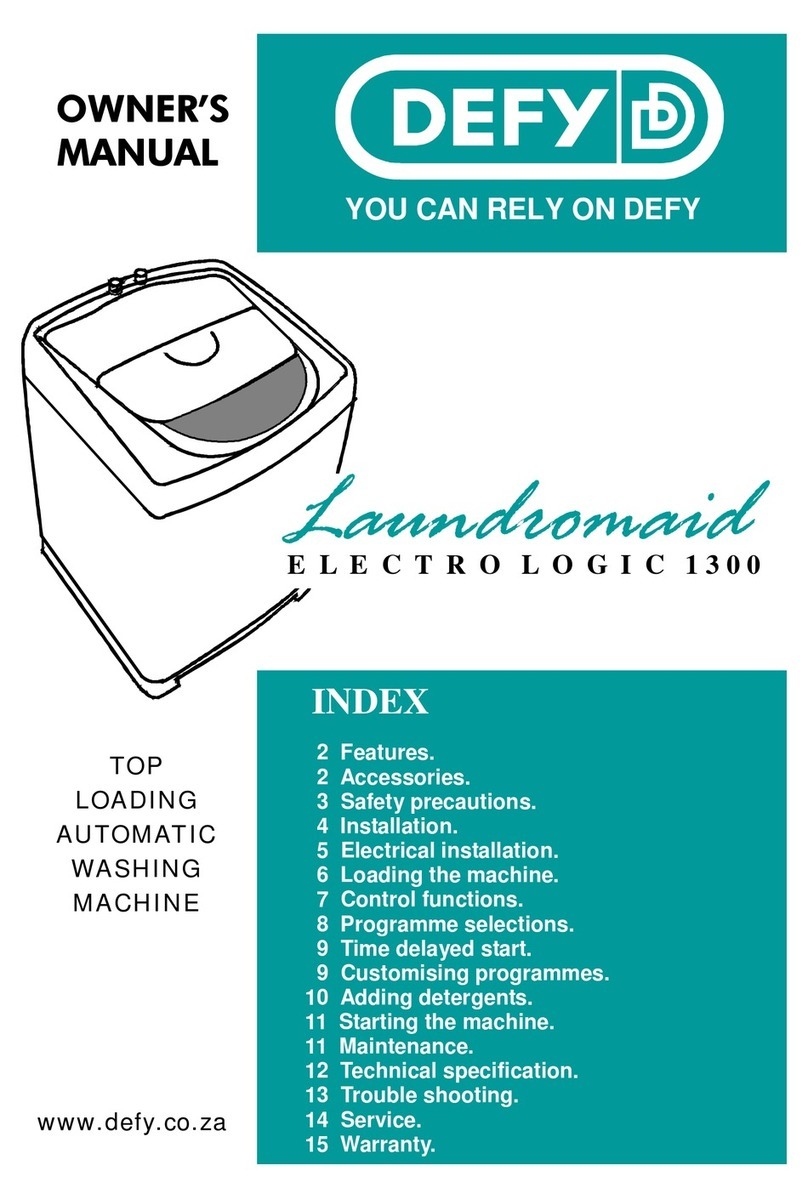
Defy
Defy LAUNDROMAID Electro Logic 1300 User manual

Defy
Defy DAW371 User manual
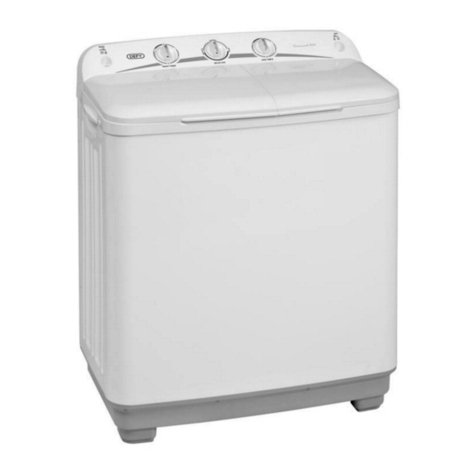
Defy
Defy Twinmaid 800 User manual
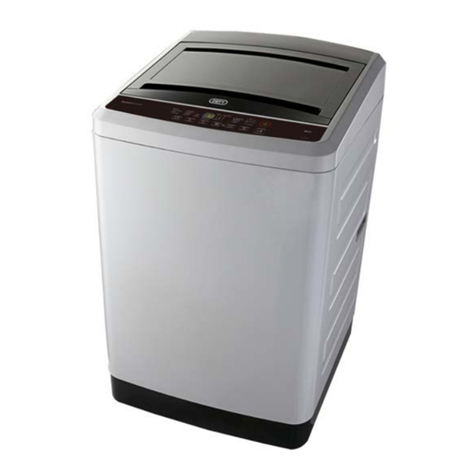
Defy
Defy DTL149 User manual
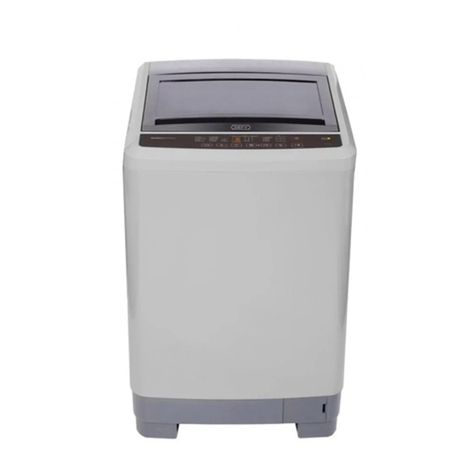
Defy
Defy DTL144 User manual
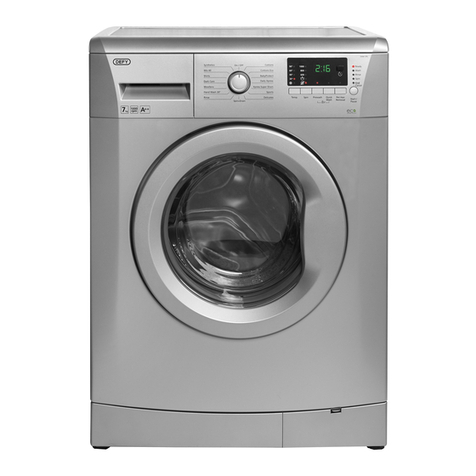
Defy
Defy DAW 376 User manual

Defy
Defy DTT169 User manual

Defy
Defy MAXIMAID 720M User manual
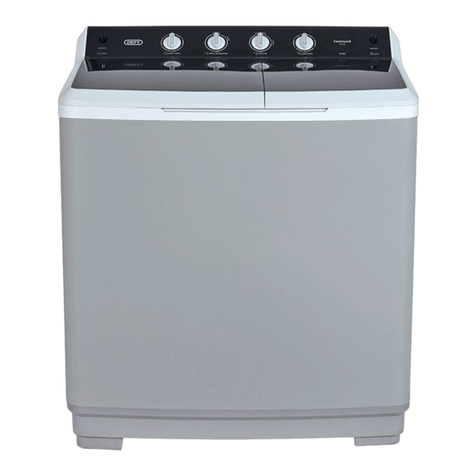
Defy
Defy DTT151 User manual
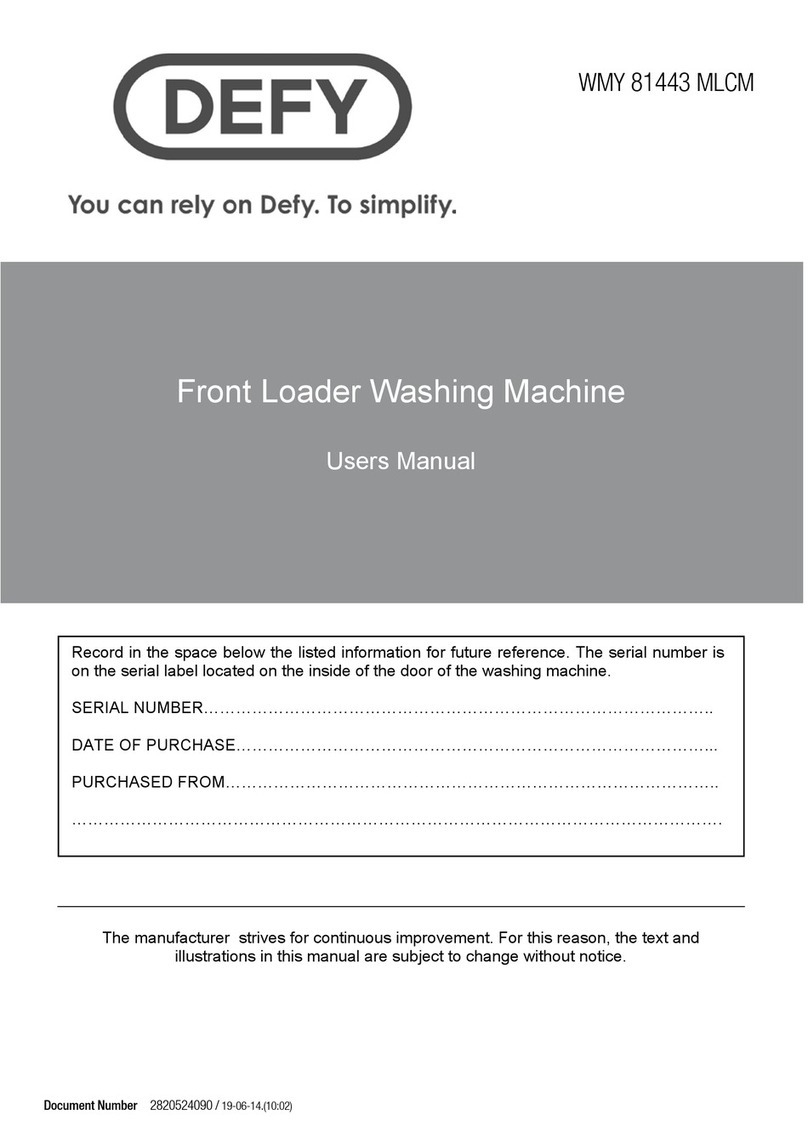
Defy
Defy WMY 81443 MLCM User manual
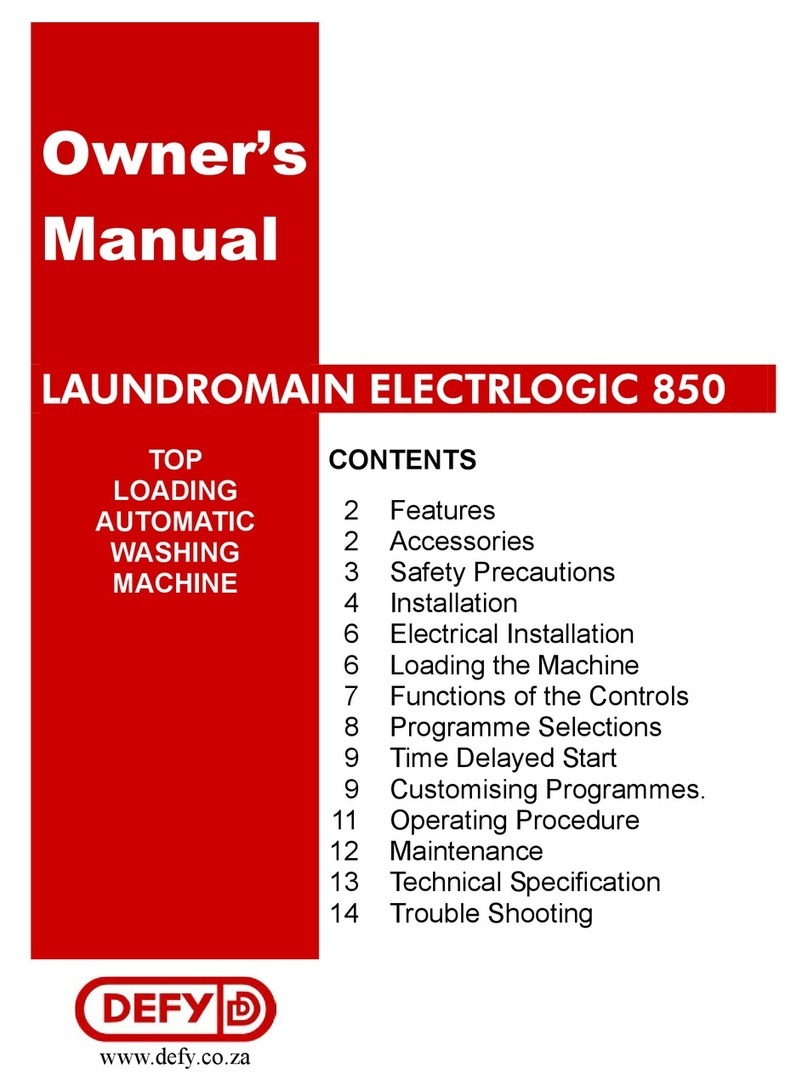
Defy
Defy Maximaid 850 User manual
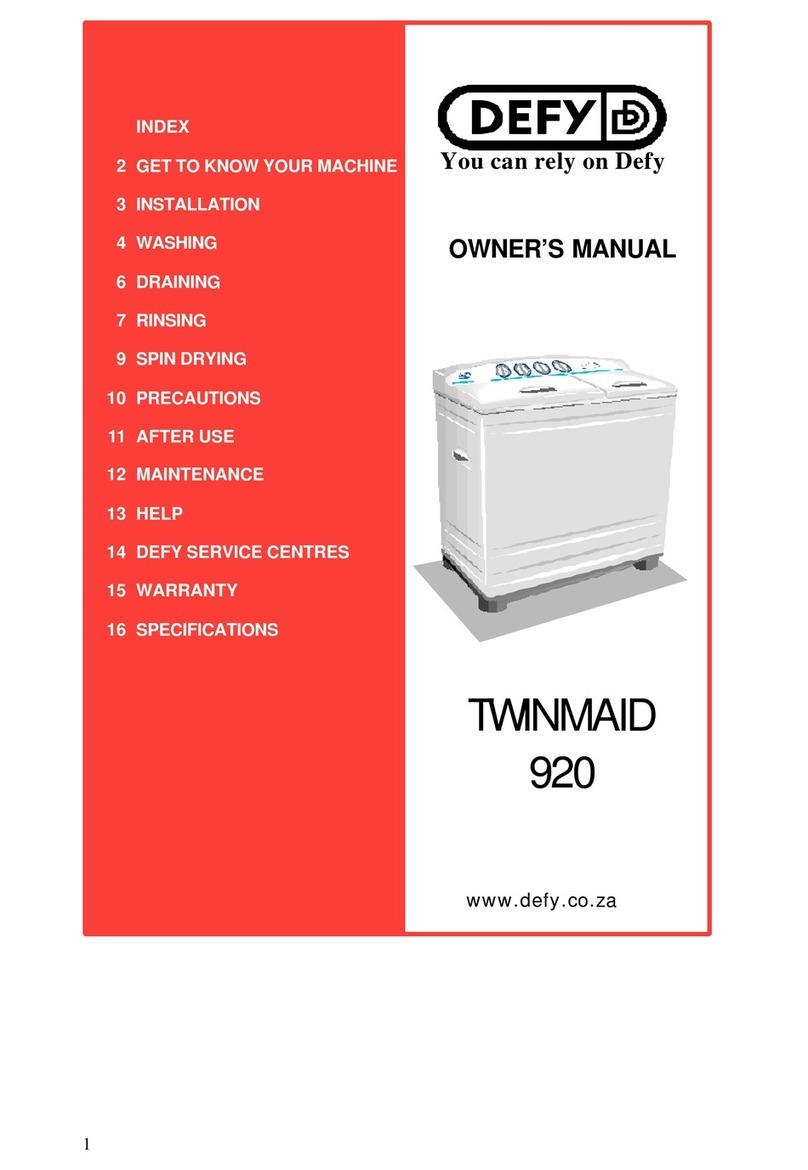
Defy
Defy TWINMAID 920 User manual

Defy
Defy DTL 137 User manual
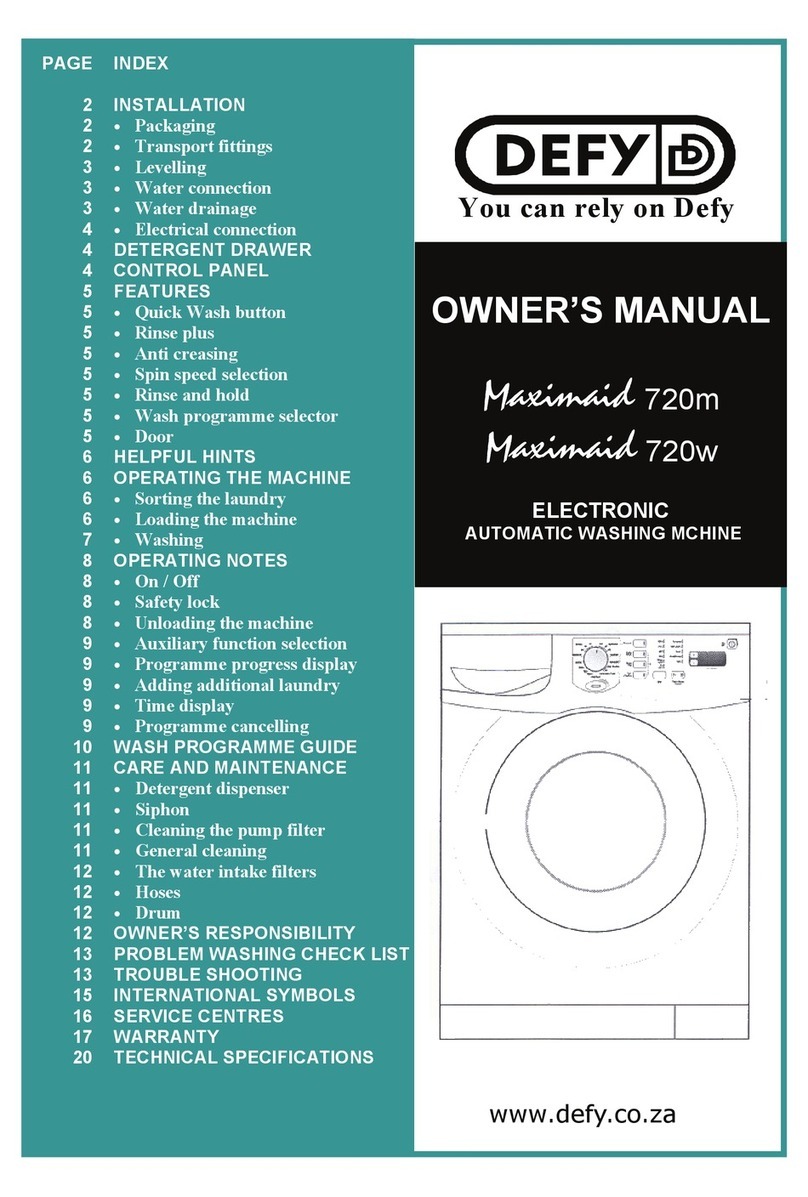
Defy
Defy MAXIMAID 720W User manual
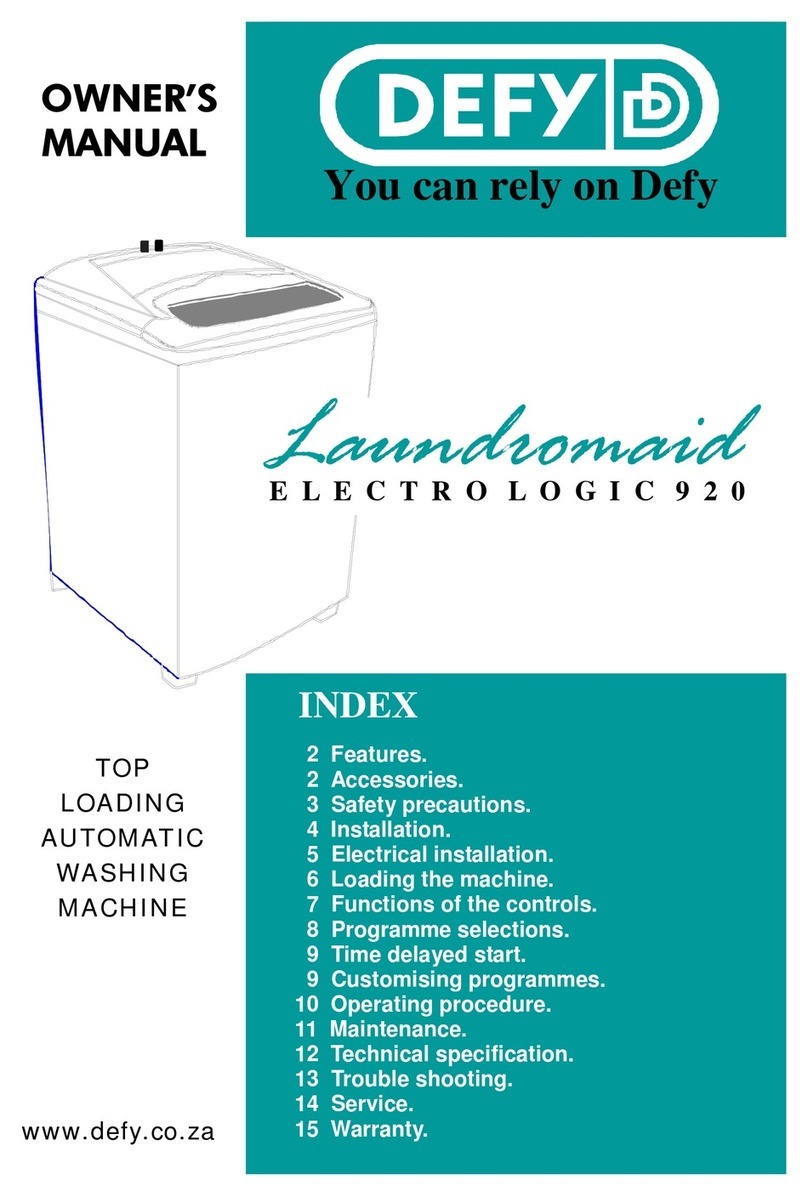
Defy
Defy LAUNDROMAID Electro Logic 920 User manual
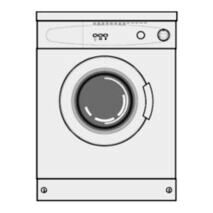
Defy
Defy Automaid 600 electronic User manual

Defy
Defy DTT180 User manual
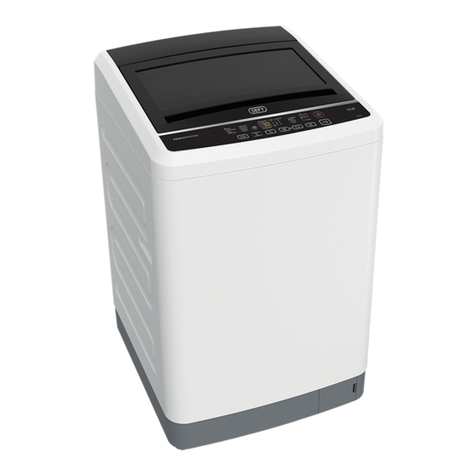
Defy
Defy DTL148 User manual

Defy
Defy DTL160 User manual

Defy
Defy WMY 71283 MLCW User manual
